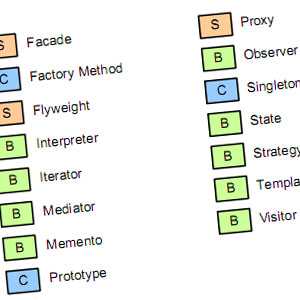
Mediator pattern
Information drawn from
It is a behavioural design pattern that encapsulates how a set of objects interact with each other. It provides the central authority over a group of objects by promoting loose coupling, keeping objects from referring to each other explicitly.
In this example, we have TrafficTower as Mediator that controls the way Airplane objects interact with each other. All the Airplane objects register themselves with a TrafficTower object, and it is the mediator class object that handles how an Airplane object receives coordinates data of all the other Airplane objects.
class TrafficTower {
constructor() {
this._airplanes = [];
}
register(airplane) {
this._airplanes.push(airplane);
airplane.register(this);
}
requestCoordinates(airplane) {
return this._airplanes.filter(plane => airplane !== plane).map(plane => plane.coordinates);
}
}
class Airplane {
constructor(coordinates) {
this.coordinates = coordinates;
this.trafficTower = null;
}
register(trafficTower) {
this.trafficTower = trafficTower;
}
requestCoordinates() {
if (this.trafficTower) return this.trafficTower.requestCoordinates(this);
return null;
}
}
// usage
const tower = new TrafficTower();
const airplanes = [new Airplane(10), new Airplane(20), new Airplane(30)];
airplanes.forEach(airplane => {
tower.register(airplane);
});
console.log(airplanes.map(airplane => airplane.requestCoordinates()))
// [[20, 30], [10, 30], [10, 20]]
------------------------------------------------------------------------
Last update on 03 Feb 2020
---